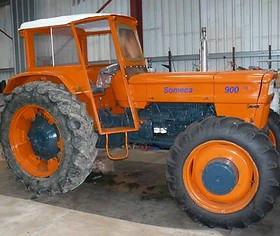top of page
FIAT 900








By 1967, Fiat was leading the European market, and its 50th anniversary was coming up. For the occasion, a new series was developed in Turin with more innovative characteristics than earlier models. The new series would be based on the Diamante series, and the name chosen was "Nastro d'Oro" or "Gold Ribbon", marking the "Golden Anniversary" of Fiat's "marriage to the land".
The appearance was a strong evolution of the Diamant series, again penned by Pinninfarina, with the longitudinal ribs of the engine cover now more predominant, and running though to the nose conferring lightness and movement. The colors were slightly changed as well, with a lighter orange for the bodypart, and blue for the mechanical parts, which gave the impression of a dynamic and modern machine.
The new series wasn't only a styling exercise though. The series introduced new upgraded engines, all now with direct injection and rotary injection pumps, and all but the smallest reverting to a stressed crankcase design. Improved driving ergonomics, a number of new safety features including a lock preventing starting the engine while in gear, new 12 volt electrical system, upgraded gearboxes with synchronizers, and the control-matic three-point hitch now standard on all models, are just a few of the technical features to mention.
Some sources tell, that all models at launch had the option of a Frutteto, Vigneto and Granluce variant, though this has been difficult to confirm.
The first models of the "Nastro d'Oro series"/"Gold Ribbon series", were put into production in 1968.
The 900 was introduced in 1969 together with the 850. This was the first wheeled Fiat tractor to be fitted with a 6 cylinder engine, developed from the 854 (8045) engine in the 550. An engine that would become the basis for all medium to medium-large size Fiat tractors from 1972 till 2003.
The model only lasted for three years. The engine, even though five horsepower stronger than the smaller 850, was noticeably down on torque, due to its smaller displacement.
Fiat therefor developed the 900 and its engine into the 1000, while the 850 became the 850 Super (in some markets the 940), filling the space between the 780 and 1000.
Domestically and internationally, the 900 was sold under the Fiat brand. Except for France, where it was sold under Fiat's Someca brand.
The 900 used a stressed chassis design, with the engines cast-iron crankcase being part of the tractors backbone.
The gearbox in the 900 was the completely new fully synchronized gearbox with 12 forward and 4 reverse gears. The positioning of the gearlevers were new as well, having found their way to the instrumentpanel, reaching out from under the steering wheel. A placement that would come to define the driving experience of all medium and large size Fiat tractors, until the Ferrari-inspired gated shifter in the 1990 Winner-series.
PTO now had two speeds of 540 and 1000 rpm, and locking differential was standard on the rear axle.
The 900 used a six cylinder watercooled, direct injected diesel engine, with a displacement of 4.675cc, developing 90 hp at 2.400 rpm and 285 nm at 1.300 rpm.
The Gold Ribbon Series tractors enjoyed even greater success than its predecessor, being recognized for their new design, engines and features.
In 1968 alone, when the European market was contracting, Fiat produced a total of almost 60.000 tractors, 42.000 of which in Modena alone, 5.000 more than the previous year. That year also saw the production of the 500.000th Fiat tractor since 1918.
bottom of page
